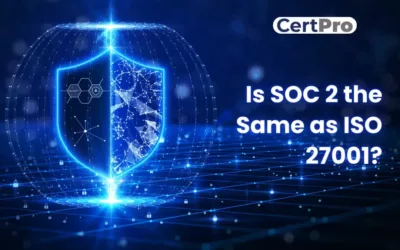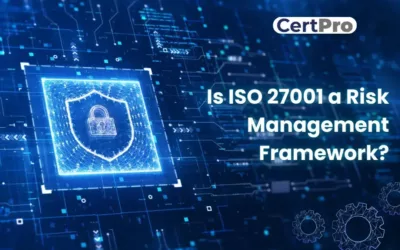Organizations often conduct an ISO 27001 gap assessment to identify areas where their existing information security processes may not meet the standards set by ISO/IEC 27001. This assessment serves as a crucial step towards achieving compliance with ISO/IEC 27001 by evaluating the organization’s current security posture, prioritizing necessary changes, and establishing a solid foundation for successful implementation.
In today’s business landscape, prioritizing information security is paramount, and establishing a robust Information Security Management System (ISMS) is crucial for safeguarding sensitive information and mitigating risks. ISO/IEC 27001, a globally recognized standard, provides a comprehensive framework for the creation, implementation, maintenance, and continual improvement of an ISMS.
Within this article, we present a comprehensive, step-by-step guide on conducting an ISO 27001 gap assessment. By following the outlined steps, organizations can gain valuable insights into their information security practices and develop a tailored plan towards achieving ISO/IEC 27001 compliance.
WHAT IS AN ISO 27001 GAP ASSESSMENT?
An ISO 27001 gap assessment is a thorough evaluation of an organization’s current information security practices and controls compared to the requirements of the ISO/IEC 27001 standard. It aims to identify gaps and areas of non-compliance, providing insights for improvement. By conducting a gap assessment, organizations can prioritize corrective actions, develop an improvement plan, and work towards achieving ISO 27001 certification. It helps organizations understand their current security posture and align their practices with the internationally recognized standard for information security management.
HOW TO BEGIN A GAP ASSESSMENT FOR ISO 27001
Before we begin, keep in mind that completing an ISO gap assessment is an iterative process. It is crucial to include significant interest groups, keep in touch with them during the evaluation, and obtain professional advice as needed. The cornerstone of a successful ISO 27001 implementation and certification journey is a thorough and well-executed gap assessment.
Let’s start with the key points of conducting an ISO gap assessment:
1. Know about the ISO/IEC 27001 requirements: Get a copy of the ISO/IEC 27001 standard, then go over the clauses, controls, and requirements. Gain comprehensive knowledge of what is required of an efficient information security management system (ISMS) by being familiar with the standard’s objectives and scope.
2. Establish the assessment’s parameters: Establish the parameters of your gap analysis. Specify the regions, divisions, procedures, or systems that will be evaluated in detail. When establishing the scope, take your organization’s size and complexity into account.
3. Create a gap assessment team: Create a team with members who are knowledgeable and skilled in information security management systems. This group will carry out the evaluation. Make sure that everyone on the team is familiar with ISO 27001 regulations.
4. Compile the necessary documentation: Gather the pertinent information on the activities, policies, procedures, and controls used by your company to protect its information. A few examples of such papers include security policies, risk assessments, incident response plans, access control processes, and any other records that represent your existing information security operations.
5. Conducting a preliminary review: To get a general idea of your organization’s current information security processes, conduct a preliminary examination of the obtained material. This will assist you in locating probable non-compliance locations and help you concentrate your evaluation efforts.
6. Conducting a gap analysis: This is the main and most important part to be done. Review the ISO/IEC 27001 standards against the present procedures and controls in your company. Find any gaps or places where your organization’s practices fall short of the standards. Interviews with important employees, document examinations, and other methods may be used to conduct this study.
7. Record the found gaps: Clearly and concisely record any found gaps or non-conformities in the ISO gap assessment and state the flaws, how they could affect information security, and which particular ISO/IEC 27001 requirements aren’t being met. This will help you get an idea of what changes are to be made.
8. Prioritize and categorize the gaps: Consider their importance and potential hazards while ranking the gaps. Depending on how they could affect information security, rank them as important or minor. This will assist you in prioritizing remedial activities and allocating resources.
9. Implement corrective actions: While conducting an ISO gap assessment, create a thorough action plan that defines the procedures, activities, and resources required to fix the gaps and Put the action plan’s suggested fixes into action to fill the identified gaps and conduct an ISO 27001 gap assessment. This might entail creating or updating rules, modernizing processes, improving technology controls, educating staff members, or putting in place new security measures as necessary and achieving compliance with ISO/IEC 27001 based on the deficiencies that have been identified.
10. Track development and review: Keep an eye on how your implementation efforts are going and assess them frequently. Ascertain that the implemented measures adhere to the specifications of the ISO/IEC 27001 standard, successfully rectify the gaps found, and help to follow ISO 27001 regulations. Your action plan may need to be modified or adjusted as appropriate.
BENEFITS OF CONDUCTING A GAP ANALYSIS
Conducting a gap analysis offers several key benefits for organizations aiming to achieve compliance with ISO 27001 and enhance their information security practices:
1. Identification of Compliance Gaps: The gap analysis helps identify areas where the organization’s current information security measures deviate from the requirements of ISO 27001. This allows organizations to understand the gaps and take appropriate actions to achieve compliance.
2. Risk Identification and Mitigation: By evaluating the existing controls and procedures, the gap analysis uncovers potential risks and vulnerabilities. This enables organizations to prioritize risk mitigation efforts and enhance their overall security posture.
3. Tailored Improvement Plan: The insights gained from the gap analysis serve as a foundation for developing a customized improvement plan. This plan outlines the specific actions needed to align the organization’s information security practices with ISO 27001 standards.
4. Enhanced Information Security: Through the implementation of the improvement plan, organizations can strengthen their information security measures, thereby protecting sensitive data, reducing the likelihood of security breaches, and fostering a culture of security awareness.
5. Demonstrates Commitment to Security: Conducting a gap analysis and working towards ISO 27001 compliance demonstrates the organization’s commitment to information security. This commitment can enhance the organization’s reputation, inspire trust among customers and partners, and differentiate it from competitors.
6. Regulatory and Legal Compliance: Achieving ISO 27001 compliance through a thorough gap analysis helps organizations meet regulatory and legal requirements related to information security. This reduces the risk of non-compliance penalties and legal issues, ensuring the organization operates within the bounds of relevant laws and regulations.
7. Continuous Improvement: The gap analysis process encourages organizations to adopt a proactive approach to information security. It fosters a culture of continuous improvement where regular assessments and updates are conducted to adapt to evolving security threats and technological advancements.
By conducting a gap analysis, organizations can gain valuable insights into their information security landscape, address vulnerabilities, and work towards achieving ISO 27001 compliance. This, in turn, enhances their ability to protect sensitive data, mitigate risks, and demonstrate their commitment to robust information security practices.

Conducting an ISO 27001 Gap Assessment with CertPro’s Expertise
The gap assessment process involves evaluating existing practices, comparing them against the standard’s requirements, and documenting the identified gaps. This enables organizations to prioritize, address areas of non-compliance, and mitigate risks.
Conducting an ISO 27001 gap assessment is a critical step for organizations seeking to enhance their information security management system. By following a systematic approach and utilizing the expertise of professionals such as CertPro (an example of an organization that provides ISO 27001 assessment services), organizations can effectively identify gaps between their current practices and the requirements of the ISO 27001 standard.
With the support of organizations like CertPro, organizations can benefit from their expertise, experience, and knowledge of best practices.
FAQ
What do we get from the gap analysis for ISO 27001?
An exhaustive report detailing the gaps or non-compliance areas found, together with suggestions for filling them, should be the result of a gap assessment. This study offers enterprises a road map for prioritizing and carrying out the required steps to achieve ISO 27001 compliance.
What kinds of gaps or non-compliance are frequently found during a gap assessment?
The vulnerability of an organization’s information security stems from factors such as the absence of clear policies, inadequate risk management, undocumented processes, insufficient employee training, ineffective business continuity plans, and disregard for legal obligations.
How long does a typical ISO 27001 gap analysis take?
The size and complexity of the organization, the breadth of the assessment, and the accessibility of pertinent material are some of the variables that affect how long a gap analysis takes. From a few weeks to many months, it is possible. Setting aside enough time is essential for carrying out a comprehensive review.
What are the essential steps in carrying out an ISO 27001 gap analysis?
The key steps are:
- Understanding the requirements of the standard is one of the main tasks.
- Doing a preliminary analysis of the information security policies.
- Gaps can be found by contrasting the existing situation with ISO criteria.
- Keep a record of the results and rank the gaps that have been found.
Who should conduct the ISO 27001 gap assessment?
Internal information security experts or consultants from outside firms with competence in ISO 27001 can carry out the gap assessment. To guarantee accuracy and efficacy, it is crucial to have employees who are knowledgeable about the standard and have expertise performing evaluations.

About the Author
SUBBAIAH KU
Subbaiah Ku is the Regional Director for CertPro in Oman, bringing a wealth of expertise in process and system auditing. As a seasoned lead assessor, Subbaiah is dedicated to ensuring the highest standards in compliance and security. His unique blend of technical acumen, rooted in Mechanical Engineering, is complemented by a diverse range of certifications and extensive training.
IS SOC 2 THE SAME AS ISO 27001?
In today's digital landscape, ensuring the safeguarding of client data is paramount for businesses. Adhering to recognized compliance standards is vital to meeting this demand. ISO 27001 vs. SOC 2 represent two prominent benchmarks in the realm of data security with...
IS ISO 27001 RISK ASSESSMENT VITAL FOR SECURITY MEASURES?
The ISO 27001 standard provides a framework for information security, highlighting the importance of a thorough risk assessment procedure. Organizations use the methodical and complex ISO 27001 risk assessment process to identify and assess information security...
ISO 27001 COMPLIANCE REPORT
The protection of sensitive information has become critical for businesses and organizations in today's digital age. With the rising frequency and sophistication of cyber threats, it is critical to implement strong security measures to safeguard critical data. ISO...




